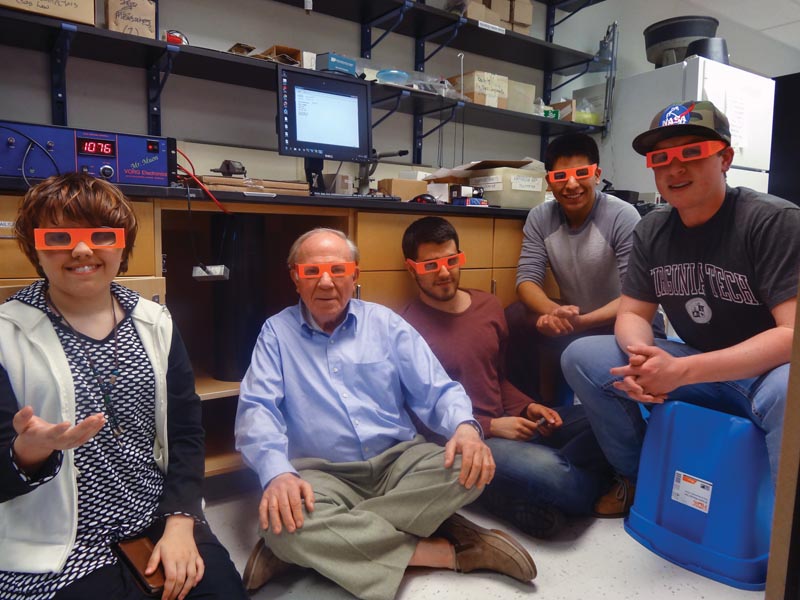Atmospheric Muon Lifetime, Standard Model of Particles, and the Lead Stopping Power for Muons
Spring
2017
Building Blocks - Undergraduate Research and Outreach Projects
Atmospheric Muon Lifetime, Standard Model of Particles, and the Lead Stopping Power for Muons
Cioli Barazandeh, SPS Member, Northern Virginia Community College
Northern Virginia Community College

The SPS chapter at the Northern Virginia Community College, Annandale, Virginia, was created in 1990 and since then has been mentored by the SPS advisor, Professor Walerian Majewski. Year after year, the chapter centers its activity not just on educating its members, but also on outreach to the physics community and beyond, to show that freshmen and sophomores can do physics research.
Our new project uses a scintillator to track muons and find the lifetime of the muon at rest, as well as calculate the lead stopping power for muons. These are not new contributions to the field of particle physics, but we want to prove that undergraduates at a community college can do serious, ambitious research. Also, our experimental design is different than other experiments that have made these measurements because we have only one muon detector. Usually stopping power is measured with two or more detectors.
Our scintillation detector was donated by the Thomas Jefferson National Accelerator Facility in Newport News, Virginia, where our advisor has friendly colleagues. An SPS research grant last year got us the money we needed to buy lead plates and bars. Since muons are accelerated to earth by cosmic rays, we don't need an accelerator—we get our particles for free!
The muon, an unstable lepton particle, is effectively a massive version of the electron. What makes it especially of note for the experiment is that it has the longest free-particle lifetime. Muons are present in the secondary cosmic ray showers in the atmosphere and are one of the few particles to reach sea level. They decay into three other leptons, which are an electron and two neutrinos (which in our experiment escape undetected). The muon detector registers arrival and stopping of a muon as a voltage pulse, which originated from its plastic scintillator, and may detect, after the time delay of about 2 microseconds, an appearance of the second pulse, which occurs from the electron created in the decay. The distribution of the individual muons’ lifetimes can be averaged in order to find the average muon lifetime at rest.
From this measured lifetime, the weak nuclear charge gw, which is an analog of the electric charge, can be calculated in terms of the known mass of the muon and the W-boson. Using another standard model relationship, which is dictated by the known unification formulas of the weak and electric forces into a single electroweak force, we can find from our muon lifetime—a totally nonelectric experiment—the value of the elementary electric charge e and so, the strength of the electromagnetic charge of e. This turns out to be a number close to the value 1.6 x 10-19 C we see in our introductory physics textbooks.
In our experiment, we will also determine the sea-level fluxes of muons. After shielding the detector with varying thicknesses of lead plates and bricks, from the new attenuated values of fluxes we can find the muon stopping power for lead, which shows how muons ionize the lead atoms in their passage through lead. Our detector permits us to measure separately properties of low-energy muons (below 150 MeV of kinetic energy) and of the high-energy muons, which on average have 4 GeV of energy.
Recently the results of the chapter’s previous muon experiments were published in the Journal of Physics Conference Series1 and in Presentations at the American Physical Society’s meeting in January 2017.2
Usually when we present at conferences, we are the only community college presenting physics research. But we would like to see other community colleges performing research like this.
This experiment is one example of research in elementary particles that is accessible to early undergraduate students from community colleges. We hope that other community colleges will follow our lead.
The students participating in the project are Cioli Barazandeh, Maryam Mohagheghi, and Angel Gutarra-leon.
ABOUT THE AUTHOR
Cioli Barazandeh received her associate's and bachelor's of science in space studies from American Military University at the ages of 12 and 13, consecutively. She began graduate coursework at the Florida Institute of Technology (FIT) before completion of her bachelor's. She is currently an FIT graduate student focusing on space systems. She is also concurrently a master's student at Purdue University engaged in the study of aeronautical and astronautical engineering funded by a full scholarship through the School of Engineering. She hopes to achieve her MS from Purdue in December 2018 and finish her MS at FIT (by May 2018), while possibly working on the research component of a doctorate. As the President of the Society of Physics Students, Annandale chapter, at Northern Virginia Community College, she currently studies with Professor Walerian Majewski and physics students, focusing on projects revolving around magnetism and particle physics.
More from this department
Building Blocks - Undergraduate Research and Outreach Projects
